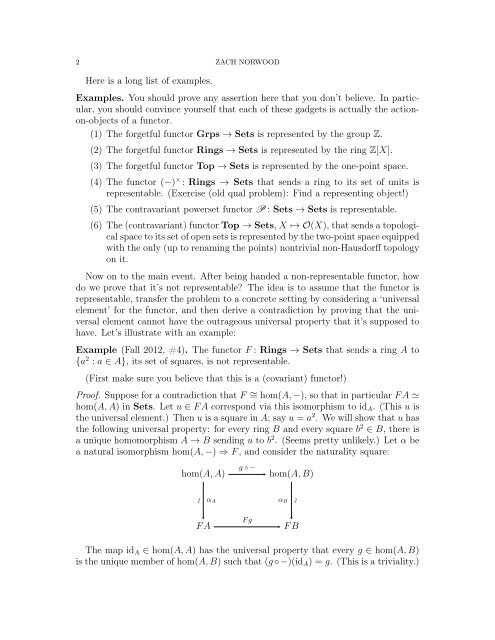HOW TO PROVE THAT A NON-REPRESENTABLE FUNCTOR IS ...
HOW TO PROVE THAT A NON-REPRESENTABLE FUNCTOR IS ...
HOW TO PROVE THAT A NON-REPRESENTABLE FUNCTOR IS ...
Create successful ePaper yourself
Turn your PDF publications into a flip-book with our unique Google optimized e-Paper software.
2 ZACH NORWOOD<br />
Here is a long list of examples.<br />
Examples. You should prove any assertion here that you don’t believe. In particular,<br />
you should convince yourself that each of these gadgets is actually the actionon-objects<br />
of a functor.<br />
(1) The forgetful functor Grps → Sets is represented by the group Z.<br />
(2) The forgetful functor Rings → Sets is represented by the ring Z[X].<br />
(3) The forgetful functor Top → Sets is represented by the one-point space.<br />
(4) The functor (−) × : Rings → Sets that sends a ring to its set of units is<br />
representable. (Exercise (old qual problem): Find a representing object!)<br />
(5) The contravariant powerset functor P : Sets → Sets is representable.<br />
(6) The (contravariant) functor Top → Sets, X ↦→ O(X), that sends a topological<br />
space to its set of open sets is represented by the two-point space equipped<br />
with the only (up to renaming the points) nontrivial non-Hausdorff topology<br />
on it.<br />
Now on to the main event. After being handed a non-representable functor, how<br />
do we prove that it’s not representable? The idea is to assume that the functor is<br />
representable, transfer the problem to a concrete setting by considering a ‘universal<br />
element’ for the functor, and then derive a contradiction by proving that the universal<br />
element cannot have the outrageous universal property that it’s supposed to<br />
have. Let’s illustrate with an example:<br />
Example (Fall 2012, #4). The functor F : Rings → Sets that sends a ring A to<br />
{a 2 : a ∈ A}, its set of squares, is not representable.<br />
(First make sure you believe that this is a (covariant) functor!)<br />
Proof. Suppose for a contradiction that F ∼ = hom(A, −), so that in particular F A <br />
hom(A, A) in Sets. Let u ∈ F A correspond via this isomorphism to idA. (This u is<br />
the universal element.) Then u is a square in A; say u = a 2 . We will show that u has<br />
the following universal property: for every ring B and every square b 2 ∈ B, there is<br />
a unique homomorphism A → B sending u to b 2 . (Seems pretty unlikely.) Let α be<br />
a natural isomorphism hom(A, −) ⇒ F , and consider the naturality square:<br />
hom(A, A) hom(A, B)<br />
∼<br />
g ◦ −<br />
αA αB∼<br />
F g<br />
F A F B<br />
The map idA ∈ hom(A, A) has the universal property that every g ∈ hom(A, B)<br />
is the unique member of hom(A, B) such that (g ◦−)(idA) = g. (This is a triviality.)
















